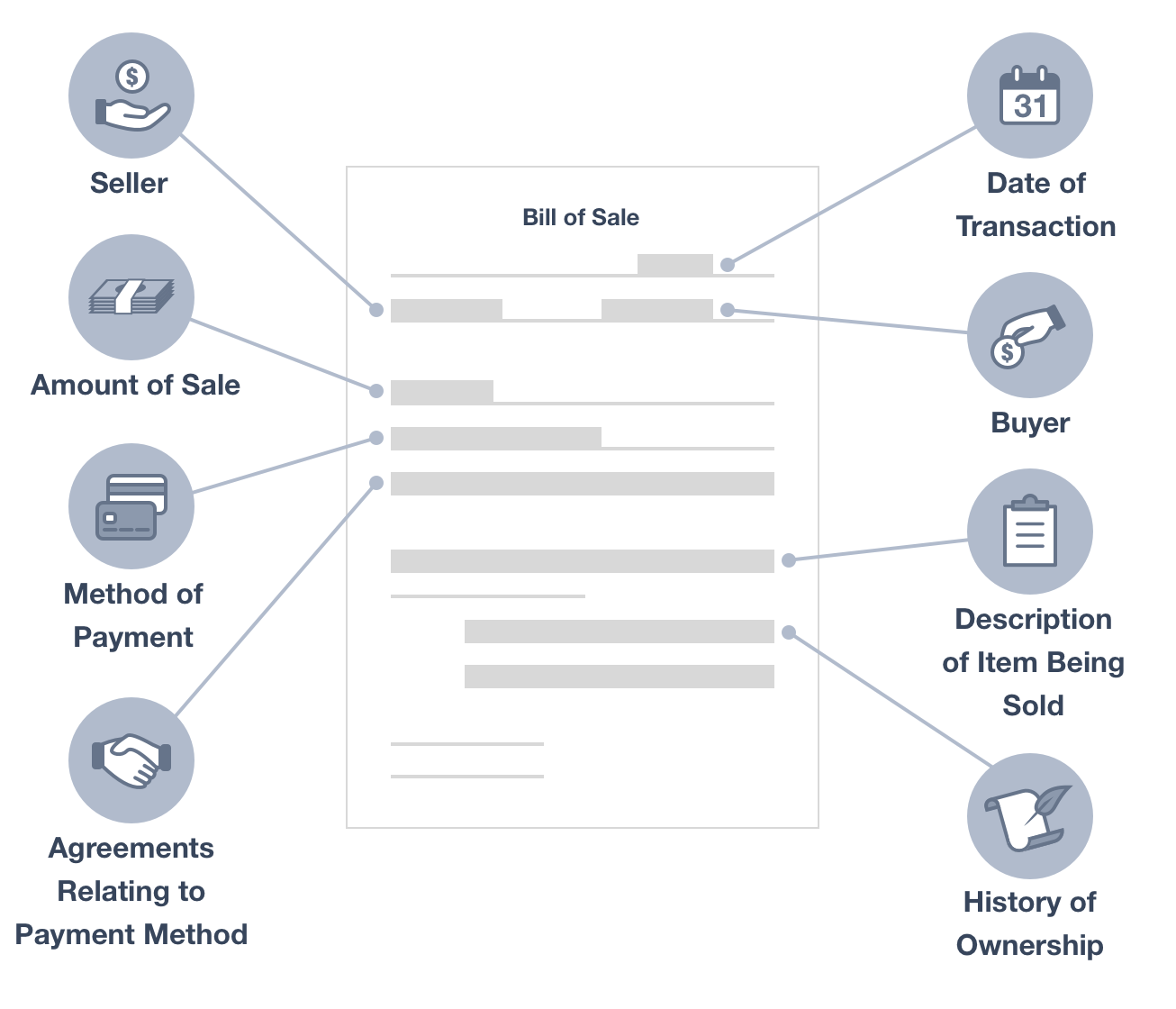What is this Bill of Sale for?
Vehicle Bill of Sale
A bill of sale for a motor vehicle is often regulated by the state where the sale takes place. In fact, some states provide a specific bill of sale form that must be used. Not all states require a bill of sale for a motor vehicle, but it does act as proof of ownership and makes an excellent personal record. Information in a bill of sale for a motor vehicle includes a description of the vehicle, the VIN, and the odometer. It will also include the price as well as the names of the buyer and the seller. It should also be signed and dated by both. It may need to be notarized depending on the state.
Create My DocumentGeneral Bill of Sale
General items may be sold with a bill of sale. Common items include used furniture, electronics, clothing, and jewelry. A bill of sale for a general item doesn't need to be notarized. A bill of sale for a general item includes a description of the item, the names of the buyer and seller, and the price and payment terms of the sale. It is also signed and dated by both parties.
Create My DocumentBoat Bill of Sale
A bill of sale for a boat is used to document the sale of a vessel. Boats must be registered in the state where they are used. This usually includes handmade boats. A bill of sale acts as proof of ownership during the registration process.
Create My DocumentFirearm Bill of Sale
A bill of sale for a firearm is used as a personal record. While there are a few cities that require gun registration where you may need to provide proof of ownership, bills of sale are usually not a legal requirement. A bill of sale for a firearm should include the make, model, caliber, and serial number of the gun.
Create My DocumentWhat Is a Bill of Sale?
A bill of sale, also called a proof of purchase or proof of payment, is a legal document used to transfer ownership of an item from the person selling it (the Seller) to the person purchasing it (the Buyer). It contains all relevant information regarding the sale, including contact information for the buyer and seller, warranty information (if applicable), date, time, and the price paid.
When creating a bill of sale, the seller is responsible for drafting the bill and including all details of the transaction.

What Does "As-Is" Mean in a Bill of Sale?
Don't be surprised if a bill of sale includes an "as-is" clause. An “as is” bill of sale stipulates that the transferred property has been inspected by the purchaser and that the seller disclaims any warranty as to the condition of the property.
In effect, the buyer is committing to buy the property “as is” without any additional warranties.
When Do You Need a Bill of Sale?
Anyone who purchases an item that may later require proof of purchase should use a bill of sale. Some unfortunate victims of fraud have purchased stolen cars. In a situation like this, a bill of sale is crucial.
Additionally, those who purchase a motorcycle, boat, trailer, or any other form of personal property should use a bill of sale. Even a simple bill of sale provides substantial benefits for both buyers and sellers.
Buying or selling a motor vehicle, for example, is a common use for a bill of sale. The Department of Motor Vehicles in many states requires a bill of sale in order to provide valid vehicle registration and certificate of title.
Benefits for Buyers and Sellers
A thorough bill of sale protects both sellers and buyers by creating a proof of transaction, reducing the risk of disputes and tax issues. Many states recommend a bill of sale for any item costing more than $500.
If you are trying to obtain insurance on an item, a signed bill of sale can serve as proof that you actually own the item.
In some bill of sale agreements, the buyer will provide a promissory note. A promissory note is a written agreement from the Buyer stating that the Buyer will pay back a loan provided by another party, such as a bank or financial institution. A promissory note allows buyers to specify how payments will be made and at what point, whether it is in installments, by a specific date, or upon demand.
What Are the Benefits for Sellers?
-
Ease of tax reporting
-
"As-is" protection
-
Date of ownership transfer
What are the Benefits for Buyers?
-
Proof of ownership
-
Date of ownership transfer
-
Warranty information
Popular Bill of Sale Templates
With FormSwift, you can customize your bill of sale for many different items, including but not limited:
Can I use a Bill of Sale as a receipt?
No. In this situation, it’s better to use an independent contractor agreement or consulting agreement. Bill of sales are used for physical goods, not services.
A bill of sale is also not best for real estate transactions. For these, consider a warranty deed or quit claim deed.
How do I write a Bill of Sale?
To create a bill of sale, you’ll need the following information:
-
Property Location - This section of the bill of sale form specifies the location of the item being sold. Typically this includes only general location information: city, county, state, zip code, etc. Our bill of sale template also includes a brief description of the item being sold.
-
Seller(s) - This section includes the main seller's contact information, including his or her full name and address. It is also where any additional sellers are noted.
-
Buyer(s) - This section provides the contact information of the buyer. It also lists information about any additional buyers.
-
Price - This lists the purchase price the buyer will pay for the property in question. Typically subtotals are not itemized on a bill of sale, only the total sale price.
-
The Form of Payment - This specifies what payment method the buyer will use. Options include cash, personal check, certified check, money order, etc.
-
Sales Tax - This section specifies how sales tax will affect the price. It is either included in the prices or added to the price.
-
Property - This includes the date of property transfer. It also specifies whether the item is being sold "as is" or under warranty. If the item is being sold "as is," the bill of sale states that the buyer has had the opportunity to inspect and approve the item's condition. If you are buying or selling a motor vehicle, be sure to include the VIN (Vehicle Identification Number), license plate number, and odometer disclosure statement (odometer reading).
-
Witness Information - This section is only pertinent if a witness will be present to sign the bill of sale. It includes the witness's full name, address, and other contact information. The witness can either be a notary public or a party agreed upon by the Buyer and Seller.
-
As-is - The as-is clause certifies that the buyer is agreeing to purchase the item in its current state at the time of sale.
-
VIN (Vehicle Information Number) - A VIN is a car's serial number; it is 17 characters in length and will correspond to the manufacturing details of the car, such as the specific model, the location of where it was built, and the year that the car was made.
-
Gift - This part of the bill of sale is used to identify whether the item is being sold as a gift to the recipient. If the gift box is checked on a bill of sale, it will carry specific tax stipulations for that calendar year.
-
Trade-In - When you are trading in one item for another, the trade-in bill of sale will certify the current value of each item to ensure that each party is receiving proper value for the exchange.
Download a PDF or Word Template
Bill of Sale
A bill of sale records important information about the exchange of personal property. It will give information about the buyer, the seller, and the property that is being sold.
 Read More
Read More
Vehicle Bill of Sale
A Vehicle Bill of Sale is a legal document evidencing the detail of exchanged ownership of a vehicle. It establishes an 'as is' assumption that the buyer accepts the purchase in its current condition. The bill details names and addresses of buyer and seller, date of sale, price, vehicle registration and other details.
 Read More
Read More
Boat Bill of Sale
If you're buying or selling a boat, you need a boat bill of sale. This document displays information about the buyer, the seller, and important information about the boat that is being sold.
 Read More
Read More
Lease Agreement
A lease agreement establishes the terms and conditions for borrowing or rental of property, be it real estate, equipment or other asset. It details the parties, the leased property, duration of the lease, expectations, rights and obligations of both parties. When signed it is legally enforceable.
 Read More
Read More




